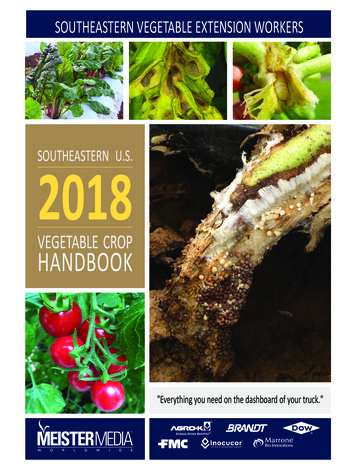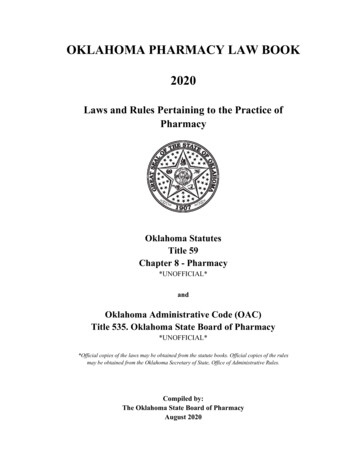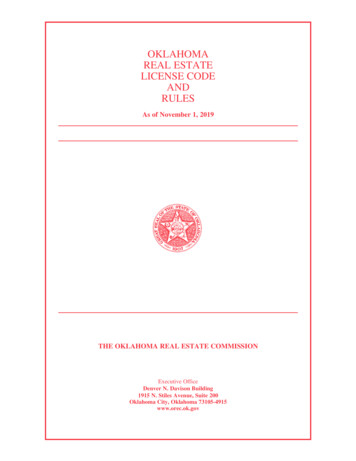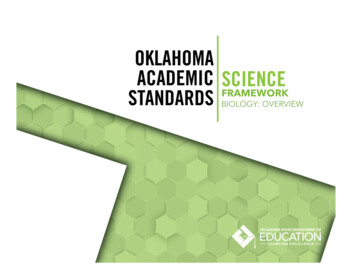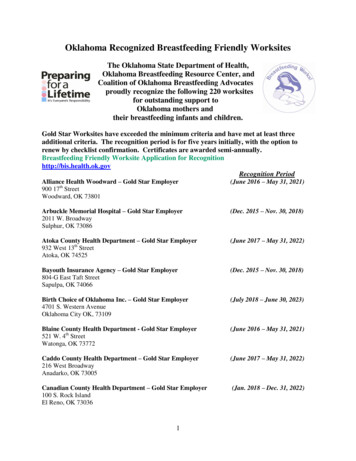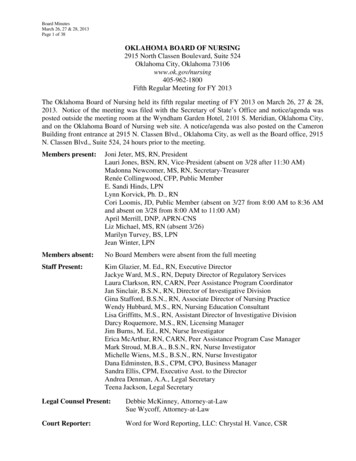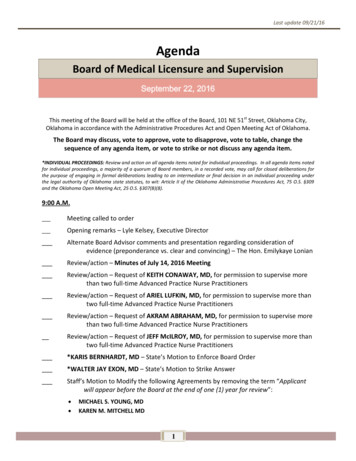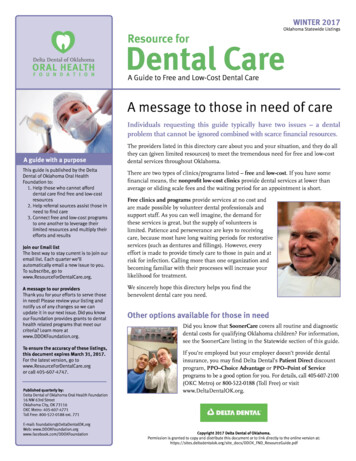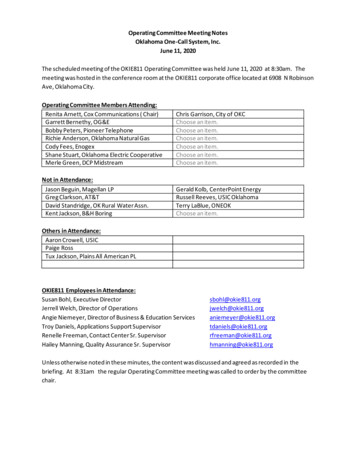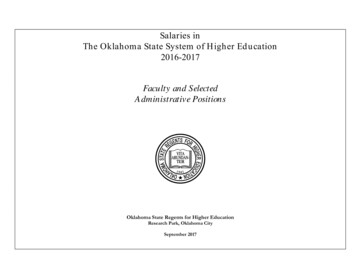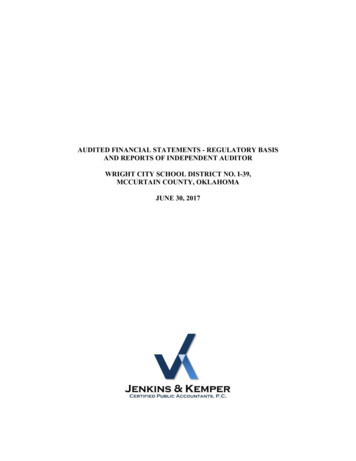
Transcription
SCIENCE
It is the policy of the Oklahoma State Department of Education (OSDE) not to discriminate on the basis of race, color, religion, gender, national origin, age, or disability in its programsor employment practices as required by Title VI and VII of the Civil Rights Act of 1964, Title IX of the Education Amendments of 1972, and Section 504 of the Rehabilitation Act of 1973.Civil rights compliance inquiries related to the OSDE may be directed to the Affirmative Action Officer, Room 111, 2500 North Lincoln Boulevard, Oklahoma City, Oklahoma 73105-4599,telephone number (405) 522-4930; or, the United States Department of Education’s Assistant Secretary for Civil Rights. Inquires or concerns regarding compliance with Title IX by local schooldistricts should be presented to the local school district Title IX coordinator.This publication, printed by the State Department of Education Printing Services, is issued by the Oklahoma State Department of Education as authorized by 70 O.S. § 3-104. Five hundredcopies have been prepared using Title I, Part A, School Improvement funds at a cost of .15 per copy. Copies have been deposited with the Publications Clearinghouse of the OklahomaDepartment of Libraries. DECEMBER 2013.
SCIENCETable of Contents5-89IntroductionK-5 Overview10-18 KINDERGARTEN19-28 1ST GRADE29-39 2ND GRADE40-54 3RD GRADE55-68 4TH GRADE69-82 5TH GRADE836-12 Overview84-101 6TH GRADE102-119 7TH GRADE120-137 8TH GRADE138-152 PHYSICAL SCIENCE153-165 CHEMISTRY166-181 PHYSICS182-203 BIOLOGY I204-219 EARTH & SPACE SCIENCE220-235 ENVIRONMENTAL SCIENCE
IntroductionScience uses observation and experimentation to explain natural phenomena. Science refers to an organized body ofknowledge that includes core ideas from the disciplines of science and common themes that bridge the disciplines. TheOklahoma Academic Standards for Science include standards for kindergarten through grade twelve. The standards arearranged by grade levels at Grades K-8, and by course subject area at the high school level. The Oklahoma AcademicStandards include the integration of scientific and engineering practices with core content from Physical Science, Life Science,and Earth/Space Science. This integrated approach will provide students with a coordinated and coherent understanding ofthe necessary skills and knowledge to be scientifically literate citizens.Development and Review of the StandardsExecutive CommitteeAn Executive Committee was comprised to assist in planning the process for the revision of the Oklahoma Academic Standardsfor Science and selecting representatives to comprise a Writing Committee and a Draft Committee. The Executive Committeealso served on the Writing Committee.The Oklahoma State Department of Education would like to extend a special thanks to the following members of the ExecutiveCommittee who gave their time, services and expertise to the revision process: Dr. Paul Risser (University of Oklahoma) Dr. Julie Angle (Oklahoma State University) Sarah Vann (Owasso Middle School) Missy Dominy (Gordon Cooper Technology Center)Writing CommitteeA Writing Committee was selected through an application process to revise the Oklahoma Academic Standards for Science.The committee met in person on six occasions and numerous times virtually. The committee was comprised of 37representatives from K-12 education, higher education, career technology, scientists, engineers, parent and communitymembers from across the state.Janice Airhart (Broken Arrow PS)Carrie Akins (Mid-Del Public Schools)Dr. Julie Angle (Oklahoma State University)Christa Askins (Bixby PS)Theresa Balan (Moore PS)Johana Benson (Bing)Renee Bell (Mid Del PS)Quentin Biddy (K20 Center– University of Okla.)Jennifer Bobo (Stillwater PS)Lori Chafee (Mustang PS)Hal Clary (Noble Public Schools)Deborah Coffman (Broken Arrow PS)Richard Day (Union PS)Wanda Dickenson (Wellston PS)Chris Dobbins (Comanche PS)Missy Dominy (Gordon Cooper Tech. Center)Tina Fugate (Okla. State Career Technology)Cora James (Putnam City PS)Laura Johnston (Velma-Alma PS)Teri Kimble (Hydro-Eakly PS)Dr. Tim Laubach (University of Oklahoma)Gaile Loving (Mustang PS)Tanya Mantooth (Wayne PS)Bob Melton (Putnam City PS)Norma Neely (American Indian Institute –University of Oklahoma)Jeffery Patterson (Norman PS)Kendra Phillips (Muldrow PS)Patrice Powdar (Moore PS)Alisa Reimer (Cordell PS)Dr. Paul Risser (University of Oklahoma)Tina Rogers (Woodward Public Schools)Georgia Smith (Bristow PS)Amanda Smith (Moore PS)Sara Snodgrass (Noble)Sarah Vann (Owasso PS)Dr. Dan Vincent (University of Central Okla.)Cathy Walker (Stillwater PS)Brandi Williams (Edmond Public Schools)Craig Walker (OSDE)Tiffany Neill (OSDE)Draft CommitteeA Draft Committee was selected through an application process to review draft standards developed by the WritingCommittee and provide feedback. The committee was comprised of 21 representatives from K-12 education, higher education,career technology, scientists, engineers, parent and community members from across the state.Peggy Alexander (Owasso PS)William Bass (Berryhill PS)Tom Creider (Okla. Tourism & Recreation Dept.)Wendy Howard (Fredrick PS)Carol Huett (Moore PS)Amy Johnson (Deer Creek PS)Kristi Carrluci (Osteology Museum)SCIENCE STANDARDSJennifer Koeninger (Mustang PS)Laura Lewis (Shawnee PS)Don Loving (Murray State College)Derrick Meador (Jennings PS)Debi Merkey (Cordell PS)Timothy Munson (OERB-Chairperson)Traci Richardson (Stillwater PS) Dr. Michael Soreghan (University of Oklahoma)Candy Schrack (Piedmont PS)Rebecca Spinks (Tulsa PS)Janis Slater (K20 Center – University of Okla.)Gaylen Urie (Glenpool PS)Dr. Laura Wilhelm (Oklahoma City University)Connie Ward (Piedmont PS)OKLAHOMA STATE DEPAR TMENT OF EDUCATION5
Focus GroupsAn additional level of review of the draft version of the Oklahoma Academics Standards for Science was conducted throughFocus Groups. Over 500 educators and community members participated in meetings held in Bristow, Durant, Guymon,Hugo, Lawton, Oklahoma City, Ponca City, Tulsa, Woodward, and Vinita. Participants were able to review samples of the draftstandards and provide feedback to the Writing Committee.Oklahoma Academic StandardsStatewide AssessmentThe Oklahoma Academic Standards describe the specificareas of student learning that are considered the mostimportant for proficiency in the discipline at a particular leveland provide a basis for the development of local curricula andstatewide assessments.The Oklahoma Academic Standards for Science are definedas performance expectations and will be used as the basisfor the development and/or refinement of questions on theOklahoma State Testing Program. Although efforts to beginimplementation of these Oklahoma Academic Standards willbegin in the 2014-2015 school year, the Oklahoma School Testing Program will continue to assess standards and objectivesfound in the 2011 Oklahoma Academic Standards for Sciencethrough the 2015-2016 school year. The test blue prints willcontinue to align to the standards and objectives of the 2011Oklahoma Academic Standards for Science through the 20152016 school year. In the 2016-2017 school year, the OklahomaState Testing Program will begin measuring the performanceexpectations defined in the 2014 Oklahoma AcademicStandards for Science for 5th grade, 8th grade, and Biology I.The Oklahoma Academic Standards in this document are notsequenced for instruction and do not prescribe classroomactivities; materials; or instructional strategies, approaches,or practices. The Oklahoma Academic Standards are not acurriculum and they do not represent a scope, sequence, orcurriculum guide. They provide a framework for schools andteachers to develop an aligned science curriculum. Suchcurriculum includes instructional units, lessons, and tasks;formative and summative assessments; opportunities forremediation and acceleration; and other selected activities,interventions, and strategies deemed appropriate and meaningful for the academic success of students.The Oklahoma Academic Standards in this document wereinformed by A Framework for K-12 Science Education(National Research Council, 2012), Benchmarks for ScienceLiteracy (American Association for the Advancement of Science,1993), The Next Generation Science Standards (2013) andthe Oklahoma Priority Academic Student Skills for Science(Oklahoma State Department of Education, 2011).Because each of the standards subsumes the knowledge andskills of the other standards, they are designed to be used asa whole. Although material can be added to the standards,using only a portion of the standards will leave gaps in thescientific understanding and practice of students.6SCIENCE STANDARDS Consistent with the current structure of the Oklahoma StateTests for science, questions will measure the practices andthe core content at each grade level. In addition, most performance expectations may be assessed with items that utilizeany of the science and engineering practices. For example, anassessment item for a performance expectation that requiresstudents to construct explanations may also ask students touse other practices such as asking questions, using models,or analyzing data around the core content with a science andengineering practice.Structure of this DocumentEach Performance Expectation is displayed in a StandardDocument that contains one Performance Expectation alongwith supporting structures intended to assist educators inunderstanding the expectation of the standard and the skillsand knowledge associated with the standard. These components are explained on page 6. Also, see reference sampledocument on page 7.OKLAHOMA STATE DEPAR TMENT OF EDUCATION
Components of a Standard Document Performance ExpectationPerformance Expectations represent the things students shouldknow, understand, and be able to do to be proficient in science.Performance Expectations are the standards.Each Performance Expectation is built around A Frameworkfor K-12 Science Education recommendation that science education in grades K-12 be built around three major dimensions:1. Science and Engineering Practices2. Crosscutting Concepts3. Disciplinary Core Ideas (NRC, 2012, p. 2)The additional components in the standard documents serveas support for instructors in providing clarity and further guidance for each Performance Expectation. Clarification StatementWhere needed, a Clarification Statement accompanies aPerformance Expectation. The aim of a Clarification Statementis to provide further explanation or examples to better support educators in understanding the aim of the PerformanceExpectation. Assessment BoundaryWhere applicable, an Assessment Boundary accompanies aPerformance Expectation in order to provide additional supportfor educators in understanding the intent of the PerformanceExpectation and its relation to other Performance Expectationsin the learning progression. While all teachers can utilize theAssessment Boundary as a tool for developing curriculum andlocal assessments, the Assessment Boundaries for 5th grade,8th grade, and Biology will be utilized as a guide in thedevelopment of the Oklahoma Core Curriculum Tests. Science and Engineering PracticesThe Science and Engineering Practices describe the majorpractices that scientists employ as they investigate and buildmodels and theories about the world and a key set of engineering practices that engineers use as they design and buildsystems. The term “practice” is used instead of the term “process” to emphasize that scientists and engineers use skill andknowledge simultaneously, not in isolation. The eight scienceand engineering practices are:1. Ask questions and define problems2. Develop and use models3. Plan and conduct investigations4. Analyze and interpret data5. Use mathematical and computational thinking6. Construct explanations and design solutions7. Engage in scientific argument from evidence8. Obtain, evaluate, and communicate informationEach Performance Expectation integrates one of the aboveScience and Engineering Practices with a Disciplinary CoreSCIENCE STANDARDS Idea in science. The integration of Science and EngineeringPractices with science content represents a shift from previousscience standards in Oklahoma, giving the learning contextand allowing students to utilize scientific reasoning and criticalthinking to develop their understanding of science. Disciplinary Core IdeasThe Disciplinary Core Ideas represent a set of science andengineering ideas for K-12 science education that have broadimportance across multiple sciences or engineering disciplines;provide a key tool for understanding or investigating morecomplex ideas and solving problems; relate to the interestsand life experiences of students; be teachable and learnableover multiple grades at increasing levels of sophistication.(NRC, 2012, p. 31)Disciplinary Core Ideas are grouped into three domains:1. Physical Science (PS)2. Life Science (LS)3. Earth and Space Science (ESS)Each Performance Expectation integrates at least one Disciplinary Core Idea with a Science and Engineering Practice. Crosscutting ConceptsThe Crosscutting Concepts represent common threads orthemes that span across science disciplines (biology, chemistry,physics, environmental science, Earth/space science) and havevalue to both scientists and engineers because they identifyuniversal properties and processes found in all disciplines.These crosscutting concepts are:1. Patterns2. Cause and Effect: Mechanisms and explanations3. Scale, Proportion, and Quantity4. Systems and System Models5. Energy and Matter: Flows, cycles, and conservation6. Structure and Function7. Stability and ChangeWhere applicable each of the Performance Expectationsincludes one of the above Crosscutting Concepts, therebyensuring that the concepts are not taught in isolation but reinforced in the context of instruction within the science content. Oklahoma Academic Standards ConnectionsWhere applicable the Performance Expectations provideoptional connections to the Oklahoma Academic Standardsfor English Language Arts/Literacy and Mathematics. Theconnections represent mathematics and literacy standardsthat could work in tandem with a Performance Expectation forscience. The connections are not mandatory. Integration of aconnecting English language arts or mathematics standardsis determined by the instructor and carried out in theinstruction.OKLAHOMA STATE DEPAR TMENT OF EDUCATION7
KINDERGARTENScience & Engineering PracticesDisciplinary Core IdeasNatural Resources: Living things need water, air, andresources from the land, and they live inplaces that have the things they need. Humans use natural resources foreverything they do. Asking questions (for science) and Performance ExpectationsK-ESS3-1Students who demonstrateunderstanding can: Use a model to representthe relationship between theneeds of different plants oranimals (including humans)and the places they live.Clarification Statement:Examples of relationships couldinclude that deer eat buds and leaves,therefore, they usually live in forestedareas; and, grasses need sunlight sothey often grow in meadows. Plants,animals, and their surroundings makeup a system.Assessment Boundary:N/A3-5defining problems (for engineering) Developing and using modelsModeling in K–2 builds on priorexperiences and progresses toinclude using and developingmodels (i.e., diagram, drawing,physical replica, diorama,dramatization, storyboard) thatrepresent concrete events ordesign solutions. Use a model to representrelationships in the natural world. Planning and carrying outinvestigations Analyzing and interpreting data Using mathematics and computationalthinking Constructing explanations (for science)and designing solutions (forengineering) Engaging in argument from evidence Obtaining, evaluating, andcommunicating informationK-2K-ESS3-1 Earth and Human Activity Crosscutting Concepts: Systems and System Models Systems in the natural and designed world have parts that work together.6-8Oklahoma Academic Standards ConnectionsELA/LiteracyMathematicsVisual Literacy - 1.1 Interpret Meaning - The student will interpret and evaluate various ways visual image-makers includinggraphic artists, illustrators, and news photographers representmeaning.Data Analysis - 5.1. Data Analysisb. Develops abilities to collect, describe, and record informationthrough a variety of means including discussion, drawings, maps,charts, and graphs.c. Describes similarities and differences between objects.d. Collects and analyze information about objects and events inthe environment. 9-12*The performance expectations marked with an asterisk integrate traditional science content with engineering through a Practice or Disciplinary Core Idea.SCIENCE STANDARDS8 SCIENCE STANDARDSOKLAHOMA STATE DEPAR TMENT OF EDUCATION OKLAHOMA STATE DEPAR TMENT OF EDUCATION17
K-5 OverviewThe Kindergarten through 5th Grade Oklahoma AcademicStandards for Science include the following Domains: Physical Science (PS) Life Science (LS) Earth & Space Science (ESS)The abbreviations for the Domains and Topics are utilizedin the naming system of each Performance Expectationfound in the Oklahoma Academic Standards for Science.For example, the Performance Expectation 4-PS3-1represents the following:GRADE: 4DOMAIN: Physical ScienceTOPIC: EnergySTANDARD: 1Each Domain has a set of Topicsin science that fit within that Domain: Physical Science (PS) Matter and Its Interactions (PS1) Motion and Stability: Forces and Interactions (PS2) Energy (PS3) Waves and Their Application in Technologiesfor Information Transfer (PS4) Life Science (LS) From Molecules to Organisms: Structure and Processes (LS1) Ecosystems: Interactions, Energy, and Dynamics (LS2) Heredity: Inheritance and Variation of Traits (LS3) Biological Unity and Diversity (LS4) Earth & Space Science (ESS) Earth’s Place in the Universe (ESS1) Earth’s Systems (ESS2) Earth and Human Activity (ESS3)Each grade level contains Performance Expectations fromeach Domain. However, to ensure students have a meaningfuland focused experience with science in preparation of moreadvanced topics in Middle and High School, topics are notnecessarily covered in each grade level. An example of theprogression of topics in grade span 3-5 can be found in thetable below. Physical Science Topic 2, “Motion and Stability:Forces and Interactions” (PS2) appears in grade 3 and 5but not grade 4, is highlighted in green. In contrast, LifeScience Topic 1, “From Molecule to Organisms: Structureand Function” (LS1), is highlighted in blue and occurs ineach grade level.Grade 3Grade 4Grade -ESS3-1SCIENCE STANDARDS OKLAHOMA STATE DEPAR TMENT OF EDUCATION9
K-2 KINDERGARTENK-PS2-1 Motion and Stability: Forces and InteractionsScience & Engineering Practices3-5 Asking questions (for science) anddefining problems (for engineering) Developing and using models Planning and carrying outinvestigations to answerquestions or test solutions toproblems in K–2 builds on priorexperiences and progresses tosimple investigations, based on fairtests, which provide data to supportexplanations or design solutions. With guidance, plan and conductan investigation in collaborationwith peers. Analyzing and interpreting data Using mathematics andcomputational thinking Constructing explanations (for science)and designing solutions (forengineering) Engaging in argument from evidence Obtaining, evaluating, andcommunicating informationDisciplinary Core IdeasForces and Motion: Pushes and pulls can have differentstrengths and directions. Pushing or pulling on an object canchange the speed or direction of itsmotion and can start or stop it.Types of Interactions: When objects touch or collide, theypush on one another and can changemotion.Relationship BetweenEnergy and Forces: A bigger push or pull makes thingsspeed up or slow down more quickly.Performance ExpectationsK-PS2-1Students who demonstrateunderstanding can:Plan and conduct aninvestigation to compare theeffects of different strengthsor different directions ofpushes and pulls on themotion of an object.Clarification Statement:Examples of pushes or pulls couldinclude a string attached to an objectbeing pulled, a person pushing anobject, a person stopping a rolling ball,and two objects colliding and pushingon each other (e.g. ramps such asblocks or wooden moldings with carsand balls; paper towel threaded onrope or string across the classroom).Assessment Boundary:Assessment is limited to different relativestrengths or different directions, but notboth at the same time. Assessment doesnot include non-contact pushes or pullssuch as those produced by magnets.Crosscutting Concepts: Cause and Effect6-8 Simple tests can be designed to gather evidence to support or refute student ideas about causes.Oklahoma Academic Standards ConnectionsMathematicsVocabulary – 4.2. Use new vocabulary and language in ownspeech and writing.Writing –1.3. Presents his or her own writing which may includepictures, attempts at letters, initial consonants, words, or phrasesto the group, teacher and/or parent.Modes/Forms of Writing – 2.2. Construct journal entries usingillustrations and beginning writing skills.Listening – 1.3. Follow one- and two-step directions.Speaking – 2.1. Share information and ideas speaking in clear,complete, coherent sentences.Number Sense – 2.1. Compare a group or set to another group, set, or numericalquantity and verbally explain which has more, less, or equivalent quantities.Measurement – 4.1. Linear Measurementa. Measure objects using nonstandard units of measurement (e.g., pencil, paper clip,block).b. Compare objects according to observable attributes (e.g., long, longer, longest;short, shorter,shortest; big, bigger, biggest; small, smaller, smallest; small, medium, large).c. Compare and order objects in graduated order (e.g., shortest to tallest, thinnestto thickest).d. Identify the appropriate instrument used to measure length (ruler), weight (scale),time (clock: digital and analog; calendar: day, month, year, season), and temperature(thermometer).Data Analysis – 5.1. Data Analysisb. Develops abilities to collect, describe, and record information through a varietyof meansincluding discussion, drawings, maps, charts, and graphs.c. Describes similarities and differences between objects.d. Collects and analyze information about objects and events in the environment.Data Analysis – 5.2. Create and verbally explain a data display or graph (e.g., realobject graph, pictorial graphs).9-12ELA/Literacy*The performance expectations marked with an asterisk integrate traditional science content with engineering through a Practice or Disciplinary Core Idea.10SCIENCE STANDARDS OKLAHOMA STATE DEPAR TMENT OF EDUCATION
KINDERGARTENScience & Engineering Practices Asking questions (for science) andForces and Motion: Pushes and pulls can have differentstrengths and directions. Pushing or pulling on an object canchange the speed or direction of itsmotion and can start or stop it.Defining Engineering Problems:(secondary to K-PS2-2) A situation that people want tochange or create can be approachedas a problem to be solved throughengineering. Such problems may have manyacceptable solutions.Performance ExpectationsK-PS2-2Students who demonstrateunderstanding can:Analyze data to determineif a design solution worksas intended to change thespeed or direction of anobject with a push or a pull.*Clarification Statement:Examples of problems requiringa solution could include having amarble or other object move a certaindistance, follow a particular path, andknock down other objects. Examplesof solutions could include tools suchas a ramp to increase the speed ofthe object and a structure that wouldcause an object such as a marble orball to turn and using a rope or stringto pull an object.3-5defining problems (for engineering) Developing and using models Planning and carrying outinvestigations Analyzing and interpreting dataAnalyzing data in K–2 builds onprior experiences and progressesto collecting, recording, and sharingobservations. Analyze data from tests of anobject or tool to determine if itworks as intended. Using mathematics and computationalthinking Constructing explanations (for science)and designing solutions (forengineering) Engaging in argument from evidence Obtaining, evaluating, andcommunicating informationDisciplinary Core IdeasK-2K-PS2-2 Motion and Stability: Forces and InteractionsAssessment Boundary:Assessment does not include frictionas a mechanism for change in speed.Crosscutting Concepts: Cause and Effect Simple tests can be designed to gather evidence to support or refute student ideas about causes.6-8Oklahoma Academic Standards ConnectionsELA/LiteracyMathematicsVocabulary – 4.2. Use new vocabulary and language in ownspeech and writing.Speaking – 2.1. Share information and ideas speaking in clear,complete, coherent sentences.*The performance expectations marked with an asterisk integrate traditional science content with engineering through a Practice or Disciplinary Core Idea.SCIENCE STANDARDS OKLAHOMA STATE DEPAR TMENT OF EDUCATION119-12Number Sense – 2.1. Compare a group or set to another group, set, or numericalquantity and verbally explain which has more, less, or equivalent quantities.Measurement – 4.1. Linear Measurementa. Measure objects using nonstandard units of measurement (e.g., pencil, paper clip,block).b. Compare objects according to observable attributes (e.g., long, longer, longest;short, shorter,shortest; big, bigger, biggest; small, smaller, smallest; small, medium, large).c. Compare and order objects in graduated order (e.g., shortest to tallest, thinnestto thickest).d. Identify the appropriate instrument used to measure length (ruler), weight (scale),time (clock: digital and analog; calendar: day, month, year, season), and temperature(thermometer).Data Analysis – 5.1. Data Analysisb. Develops abilities to collect, describe, and record information through a varietyof meansincluding discussion, drawings, maps, charts, and graphs.c. Describes similarities and differences between objects.d. Collects and analyze information about objects and events in the environment.Data Analysis – 5.2. Create and verbally explain a data display or graph (e.g., realobject graph, pictorial graphs).
K-2 KINDERGARTENK-PS3-1 EnergyScience & Engineering Practices3-5 Asking questions (for science) anddefining problems (for engineering) Developing and using models Planning and carrying outinvestigations to answerquestions or test solutions toproblems in K–2 builds on priorexperiences and progresses tosimple investigations, based on fairtests, which provide data to supportexplanations or design solutions. Make observations (firsthand orfrom media) to collect data thatan be used to make comparisons. Analyzing and interpreting data Using mathematics and computationalthinking Constructing explanations (for science)and designing solutions (forengineering) Engaging in argument from evidence Obtaining, evaluating, andcommunicating informationDisciplinary Core IdeasConservation of Energyand Energy Transfer: Sunlight warms Earth’s surface.Performance ExpectationsK-PS3-1Students who demonstrateunderstanding can:Make observations todetermine the effect ofsunlight on Earth’s surface.Clarification Statement:Examples of Earth’s surface couldinclude sand, soil, rocks, and water.Examples can extend beyond naturalobjects on Earth’s surface to includeman-made objects such as plastics,asphalt, or concrete.Assessment Boundary:Assessment of temperature is limitedto relative measures such as warmer/cooler.Crosscutting Concepts: Cause and Effect6-8 Events have causes that generate observable patterns.Oklahoma Academic Standards ConnectionsMathematicsVocabulary – 4.2. Use new vocabulary and language in ownspeech and writing.Comprehension – 6.3. Make predictions and confirm after reading or listening to text.Speaking – 2.1. Share information and ideas speaking in clear,complete, coherent sentences.Number Sense – 2.1. Compare a group or set to another group,set, or numerical quantity and verbally explain which has more,less, or equivalent quantities.Data Analysis – 5.1. Data Analysisb. Develops abilities to collect, describe, and record informationthrough a variety of means including discussion, drawings, maps,charts, and graphs.9-12ELA/Literacy*The performance expectations marked with an asterisk integrate traditional science content with engineering through a Practice or Disciplinary Core Idea.12SCIENCE STANDARDS OKLAHOMA STATE DEPAR TMENT OF EDUCATION
KINDERGARTENScience & Engineering Practices Asking questions (for science) andConservation of Energyand Energy Transfer: Sunlight warms Earth’s surface.Performance ExpectationsK-PS3-2Students who demonstrateunderstanding can:Use tools and materials todesign and build a structurethat will reduce the warmingeffect of sunlight on an area.*Clarification Statement:Examples of structures could includeumbrellas, canopies, and tents thatminimize the warming effect of the sun.Assessment Boundary:N/A3-5defining problems (for engineering) Developing and using models Planning and carrying outinvestigations Analyzing and interpreting data Using mathematics and computationalthinking Constructing explanations (forscience) and designing solutions (forengineering)Constructing explanations anddesigning solutions in K–2 buildson prior experiences and progressesto the use of evidence and ideas inconstructing evidence-basedaccounts of natural phenomena anddesigning solutions. Use tools and materials providedto d
science introduction k-5 overview kindergarten 1st grade 2nd grade 3rd grade 4th grade 5th grade 6-12 overview 6th grade 7th grade 8th grade physical science chemistry physics biology i earth & space science environmental science 5-8 9 10-18 19-28 29-39 40-54 55-6
